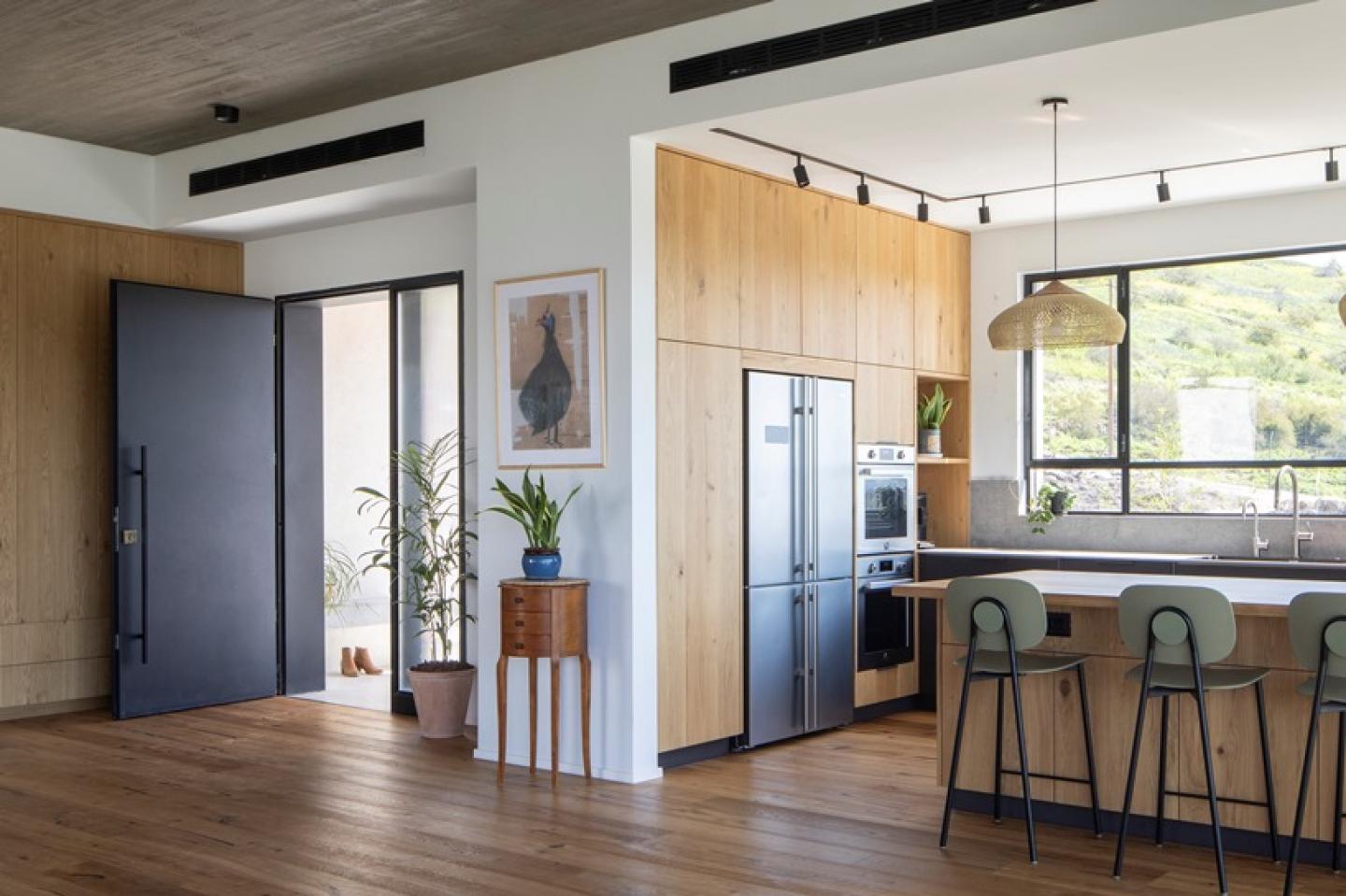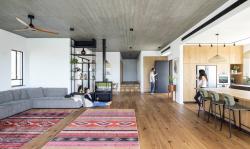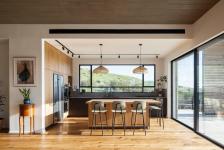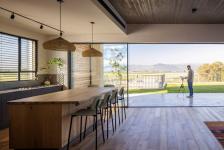The views of the Golan Heights, Hula Valley and Naftali Mountains visible from the boundaries of the plot they purchased in the expansion of Kibbutz Gonen, led the couple to commission a particularly successful project - the creation of a minimalist house with large openings, optimally expressing the pristine natural surroundings. Together with architect Inon Ben-David, they created a home that precisely meets their current and future needs, one that enjoys fantastic, endless 360° views. This is how it looks from the outside and within.
Welcome to the new home of a couple in their 30s and their two young children, located at the edge of the expansion of Kibbutz Gonen, thus enjoying a breathtaking view of the valley and mountains. The couple, who chose to leave the center for the tranquility and quality of life that only the North can provide, turned to designer Inon Ben-David, who draws inspiration from the landscapes of his childhood in the Golan Heights - the wild nature, massive rocks and raging waterfalls.
"The plot on which the house was built is located on the slope of the Golan Heights spilling into the Hula Valley, and as such, it also enjoys a panoramic view towards the Naftali Mountains visible in the distance. Given these vistas, it was natural and self-evident to design a structure with minimalist and organic lines that would connect the wings and functions to the scenery viewed up close and from afar. We were meticulous about working with and incorporating natural materials or those with a natural appearance, and a neutral color palette that maximizes the impact," says Ben-David.
"In order for the house to connect with the slope in the best and most natural way, we designed a two-level, terraced structure that harmoniously blends into the natural topography of the mountain. A flight of stairs leads to the lower level, where the public functions are located, connecting the building to the access road of the community. Only 3 steps separate the public area from the private wing, creating a sense of a continuous, flowing structure with large openings that let in an abundance of fresh air and natural light in a measured, controlled way, and of course, the view."
To create a more authentic connection between the building and the terrain and area, the homeowners chose a minimalist garden design rich in natural grass - one that blends almost completely into the wilderness and natural vegetation, really focusing on the views.
A path of large stepping stones leads visitors from the community's access trail to the home's entrance courtyard, which Ben-David chose to pave with smooth concrete and position on the southern facade, so that it is not directly visible but rather revealed in stages. "One of the reasons for the specific location of the entrance is the desire to
create a large, continuous 'showcase' about 10 meters long, through which the entire view can be seen from every angle," explains the designer. "Above it, we created an integral part of the building - a floating concrete pergola, the inner part of which is covered with smoked, thermally-treated oak slats to ensure their peak condition even in extreme climates."
"At the connection between the built pergola and the support column on the southern facade, a steel construction was embedded (an element that recurs in various parts of the house) for a dynamic wooden partition that can be left open to enjoy the view or closed to provide shade during hot hours."
The steel construction is also clearly visible in the additional pergolas surrounding the house, shading the openings and linking the functions and masses: "Like the one above the entrance door," says Ben David. "Upon opening the door, made of black iron and wired glass, the dining area is revealed opposite, with a round oak table in the center, and immediately after it a 'showcase' leading to a secluded northern terrace mainly used for morning coffee."
To the right of the entrance door, Ben-David designed an oak wardrobe and coat closet for the family, clearly intending to create as open a public space as possible to allow interaction between family members and guests. For this reason, we chose to create an airy partition between the dining area and living room, providing a conceptual separation between the functions, including an open iron bookcase for accessories and further on, a suspended fireplace. Above the public level, the exposed concrete ceiling beams created during the casting stage are clearly visible, intentionally oriented towards the large 'showcase' window and the view.
For the living room, an exceptionally large, deep and comfortable seating system was chosen, and ethnic wool rugs were spread across the parquet floor, adding color to the space designed mostly in a natural, minimalist and quiet palette.
In the center of the kitchen space, directly above the worktop, a large window was designed to bathe the entire area in light and bring in the green hues of the adjacent mountain slope. A tall wall with zenithal cabinets, the refrigerator and ovens, made of split oak fronts, leaves the kitchen open and clutter-free. "We covered the worktop with nano pormica in a charcoal shade, and chose sage green for the bar stools," says Ben-David. "Similar to the dining area, we also hung straw shades above the island, blending with the clean design concept while adding another layer of natural texture."
Three wide steps lead to the private wing, and like the house's flooring, they are also covered with natural oak planks. Ben-David created a bright, open and spacious area for the young family that still provides maximum privacy - between the parents and their children, and between the family and guests. "The private area is airy and well-lit but at the same time remains very intimate since there are no visible doors from the public wing, the flow is very pleasant, and the rooms were positioned to avoid any exposure," he explains.
In the wide hallway leading to the bedrooms, a row of cabinets for general storage was designed, with their fronts oven-painted in the same shade as the walls. On the opposite side, an impressive, wide entrance opens into the family area, designed as a neutral, dynamic cocoon that can adapt to the family's changing needs over the years. At the end of the space, a large north-facing window was designed, with a built-in bench below allowing for sitting and gazing out at the yard and view.
Next is the parents' master suite, hidden from view thanks to the couple's intimate work corner separating the bedroom from the upper level's hallway: "Although not large, it is highly efficient since first and foremost it creates a very suitable transition to the master suite, keeping it concealed from passersby in the hallway, and additionally, the large window above the desk opens up the space and creates an illusion of an almost infinite expanse," says Ben-David.
"The bedroom itself was also designed in an optimal layout and despite not being large, the flow is very functional, with the axis of closets facing the bed creating an intimate entryway to the bathroom area, and the large window overlooking the garden located beside the bed rather than above it, so the energetic feel of the space is balanced and pleasant - contributing to this is also a narrow, vertical window designed on the axis connecting the closet entryway to the bathroom, which together with the large 'showcase' window creates excellent circulation of fresh air."
"The layout in the bathroom is also very convenient, with all functions arranged along one wall, while the opposite one features a vertical window penetrating the couple's shower stall and letting in abundant light. For the shower stall's floor and feature wall, we chose terrazzo-look porcelain granite tiles in a greyish hue, while the surrounding walls were covered in a neutral, light-toned plaster."
"The children's rooms were also designed along minimalist lines and as such, will serve as a good platform for changes as they grow older."
2023
2024
For: A couple in their 30s with 2 young children
Plot Area: Approx. 750 sq.m
House Area: Approx. 200 sq.m
Architecture and Interior Design: Inon Ben-David











